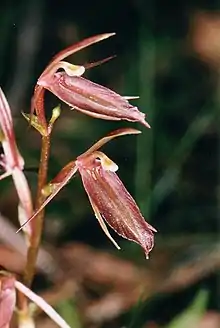| Large gnat orchid | |
|---|---|
 | |
| Cyrtostylis robusta in the Serendip Sanctuary | |
| Scientific classification | |
| Kingdom: | Plantae |
| Clade: | Tracheophytes |
| Clade: | Angiosperms |
| Clade: | Monocots |
| Order: | Asparagales |
| Family: | Orchidaceae |
| Subfamily: | Orchidoideae |
| Tribe: | Diurideae |
| Genus: | Cyrtostylis |
| Species: | C. robusta |
| Binomial name | |
| Cyrtostylis robusta | |
Cyrtostylis robusta, commonly known as large gnat-orchid[2] or mosquito orchid,[3] is a species of orchid endemic to southern Australia. It usually has a single more or less round leaf and a flowering spike with up to seven reddish flowers with a shelf-like labellum.
Description
Cyrtostylis robusta is a terrestrial, perennial, deciduous, herb with a single heart-shaped, kidney-shaped or almost round leaf 16–60 mm (0.6–2 in) long and 20–40 mm (0.8–2 in) wide. The leaf is light to medium green on the upper surface and silvery on the lower side. Between two and seven pinkish red flowers 10–20 mm (0.4–0.8 in) long and about 6 mm (0.2 in) wide are borne on a flowering stem 40–300 mm (2–10 in) high. The pedicel is 5–11 mm (0.2–0.4 in) long with a bract at its base. The dorsal sepal is erect and curved forward, linear but tapered, 10–13 mm (0.4–0.5 in) long and about 2.5 mm (0.1 in) wide. The lateral sepals are linear, 10–11 mm (0.39–0.43 in) long, 1 mm (0.04 in) wide and curve forwards or downwards. The petals are similar in size and shape to the lateral sepals and curve forwards or slightly downwards. The labellum is oblong, 10–15 mm (0.4–0.6 in) long and 4–6 mm (0.16–0.24 in) wide and slopes slightly downwards with a few serrations near its pointed tip. Flowering occurs from May to October.[2][3][4]
This species is similar to C. huegelii in Western Australia but usually has fewer, more brightly-coloured flowers with a wider labellum.[3][5] In South Australia is can be distinguished from the similar C. reniformis which has more heavily veined leaves and are green on the lower side.[6]
Taxonomy and naming
Cyrtostylis robusta was first formally described in 1987 by David Jones and Mark Clements. The description was published in the journal Lindleyana from a specimen collected near Jerramungup.[7] The specific epithet (robusta) is a Latin word meaning "oaken" or "strong like oak".[8]
Distribution and habitat
The large gnat orchid occurs in southern Victoria where it grows in coastal scrub and forest. It is found in south-eastern South Australia including Kangaroo Island and in Tasmania. It is most common and widespread in the south-west of Western Australia where it grows in near-coastal shrubland, woodland and forest between Perth and Israelite Bay.[2][3][9]
Conservation
Cyrtostylis robusta is listed as "rare" in Tasmania under the Threatened Species Protection Act 1995.[10]
References
- ↑ "Cyrtostylis robusta". World Checklist of Selected Plant Families (WCSP). Royal Botanic Gardens, Kew.
- 1 2 3 Jones, David L. (2006). A complete guide to native orchids of Australia including the island territories. Frenchs Forest, N.S.W.: New Holland. p. 164. ISBN 1877069124.
- 1 2 3 4 Brown, Andrew; Dixon, Kingsley; French, Christopher; Brockman, Garry (2013). Field guide to the orchids of Western Australia : the definitive guide to the native orchids of Western Australia. Simon Nevill Publications. p. 196. ISBN 9780980348149.
- ↑ Hoffman, Noel; Brown, Andrew (2011). Orchids of South-West Australia (3rd ed.). Gooseberry Hill: Noel Hoffman. p. 270. ISBN 9780646562322.
- ↑ Archer, William. "Large gnat orchid - Cyrtostylis robusta". Esperance Wildflowers. Retrieved 2 May 2018.
- ↑ "What orchid is this?". Native Orchid Society of South Australia. Retrieved 2 May 2018.
- ↑ "Cyrtostylis robusta". APNI. Retrieved 2 May 2018.
- ↑ Brown, Roland Wilbur (1956). The Composition of Scientific Words. Washington, D.C.: Smithsonian Institution Press. p. 566.
- ↑ "Cyrtostylis robusta". FloraBase. Western Australian Government Department of Biodiversity, Conservation and Attractions.
- ↑ "Cyrtostylis robusta". Tasmanian Government Department of Primary Industries, Parks, Water and Environment. Retrieved 2 May 2018.
External links
 Media related to Cyrtostylis robusta at Wikimedia Commons
Media related to Cyrtostylis robusta at Wikimedia Commons Data related to Cyrtostylis robusta at Wikispecies
Data related to Cyrtostylis robusta at Wikispecies